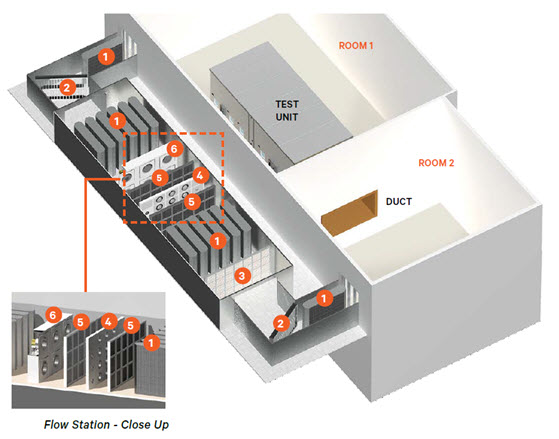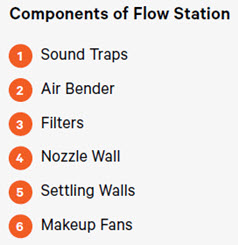Energy Labs, a Vertiv™ Company, is one of a select few manufacturers with its own state of the art testing facility. This facility, built in 2011, offers simultaneous measurement of airflow, static pressure, power consumption, and inlet and outlet sound power levels, in compliance with AMCA 210 and 300 standards.
AMCA 210 Air Flow Testing
Even certified fans don’t always meet performance ratings once installed in an AHU. Space limitations and unique flow path geometries do not replicate the ideal flow patterns that exist in a fan certification test, resulting in altered performance. To ensure that the system will perform exactly as specified, the manufacturer must have accurate and accredited factory testing capability during design, development, and validation of performance after manufacturing is completed.
Factory air flow, sound, and power measurement
Energy Labs, a Vertiv™ Company is capable of precise flow measurement at the specified project static pressure, enabling accurate sound test measurements for air handling units. Energy Labs, a Vertiv™ Company’s testing facility is capable of:
- Testing air handling units, up to 75,000 CFM, with calibrated and certified flow stations
- Variable speed make-up fans allow balancing to any pressure from 0 to 10”
- High Accuracy barometric, temperature and pressure instrumentation in accordance with AMCA 210 and 300 requirements
- Power Analyzers for accurate power and harmonic data measurements
- One of the largest dual reverberant chambers (82,750 / 45,850 ft3) in the business that allows simultaneous measurements of supply and return sound levels of large air handling units.
Leakage and Deflection Testing
All Energy Labs, a Vertiv™ Company air handling systems can be factory tested to verify air leakage performance by using one of three calibrated leak testing station. These stations measure leakage to SMACNA performance levels.
Minimizing Leakage is important as:
- Air leakage decreases unit efficiency and increases operational costs
- Can cause condensation formation at the leak site increasing unit casing corrosion and water puddling




